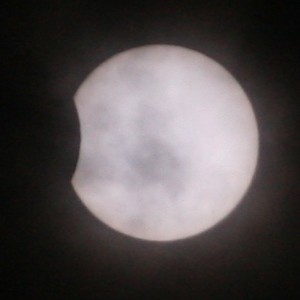
This is one of my few non-IT posts ;) Today is solar eclipse day. At my location (roughly 50N, 8E), we had a rough 10% occultation. But, as usual, the day started with a 100% occultation due to clouds. Nevertheless, I set up my PST solar scope, and a pair of eclipse “glasses”. Finally, the skies cleared up around the time the eclipse began. Not great, still lots of clouds, but, hey, this time I wasn’t after chasing fine detail. The moon could clearly be visible in front of the sun and this was what counted.
The h-alpha view in the PST was quite different, in my personal observation, from what I saw through the eclipse glasses. Most interestingly, when I initially looked I actually did not see a part of the sun being dark, but I rather “saw” the moon in front of it. I actually envisioned the moon’s globe. I thought I could even see its structured extended into the dark of the sky (especially in the PST), as an extension from its image “inside” the sun. That was rather strange. In fact, it took me some effort to forget about the moon and “just” see a piece of the sun “bitten off”. I guess this is again a good proof on how much our senses (or better our brain’s interpretation of what the senses deliver) depend on our knowledge and expectation.
As a side-note, I gathered my family around the scope and we all had a great time viewing (though me was obviously the one who had most endurance). And I should probably also mention that I screwed a biz meeting by running out loudly telling “the clouds are gone” ;). And at another time a fellow astronomer called in remembering my that I should watch. Great when people care :). And, finally, after around 75 minutes (around three quarter of the eclipses duration), it just appeared to me that I had special solar-observing save plastic film, which I than quickly moved in front of my camera. So I even have a few shots of the eclipse (one of which you can see right here at the top).
While I could not see the initial phase of the eclipse, I could see the moon move away from the sun. Very interesting.
All in all, this was a very motivating day, a real highlight. And now on to the usual stuff…
